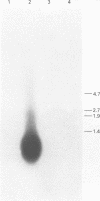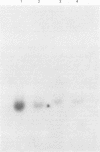Abstract
A complementary DNA library from MCF-7 cells was screened using 32P-cDNA derived from a breast carcinoma and from normal breast tissue. From 10(5) plaques (20% of library) we obtained a clone (Md2) which was differentially expressed in the carcinoma. The distribution of its corresponding transcript of 6-700 nucleotides was examined in normal and neoplastic cells, by filter and in situ hybridisation. We observed localisation of 35S-Md2 to the tumour cells of breast cancers with no significant reaction over stromal or vascular elements or on normal ductal epithelia. M13 sequencing showed Md2 to be 250 nucleotides in length, of which 197 were homologous to the 3'-untranslated region and a short open reading frame of the pS2 gene (Masiakowski et al., 1982). Md2 mRNA was found principally in breast carcinoma cell lines and tumours, with low levels in benign breast disease and no expression in non-breast squamous cell lines. Approximately 43% (23/54) of carcinomas contained this mRNA (varying from + to + + + + level); it was present in 20/38 (53%) of ER positive carcinomas compared to 3/16 (19%) of ER negative carcinomas. In 21 patients who had undergone primary endocrine therapy for recurrent disease expression of Md2 in the primary tumour correlated with the subsequent response to treatment (P = 0.041) and was of similar predictive value as ER status. Both tests correctly predicted outcome in about 76% of cases.
Full text
PDF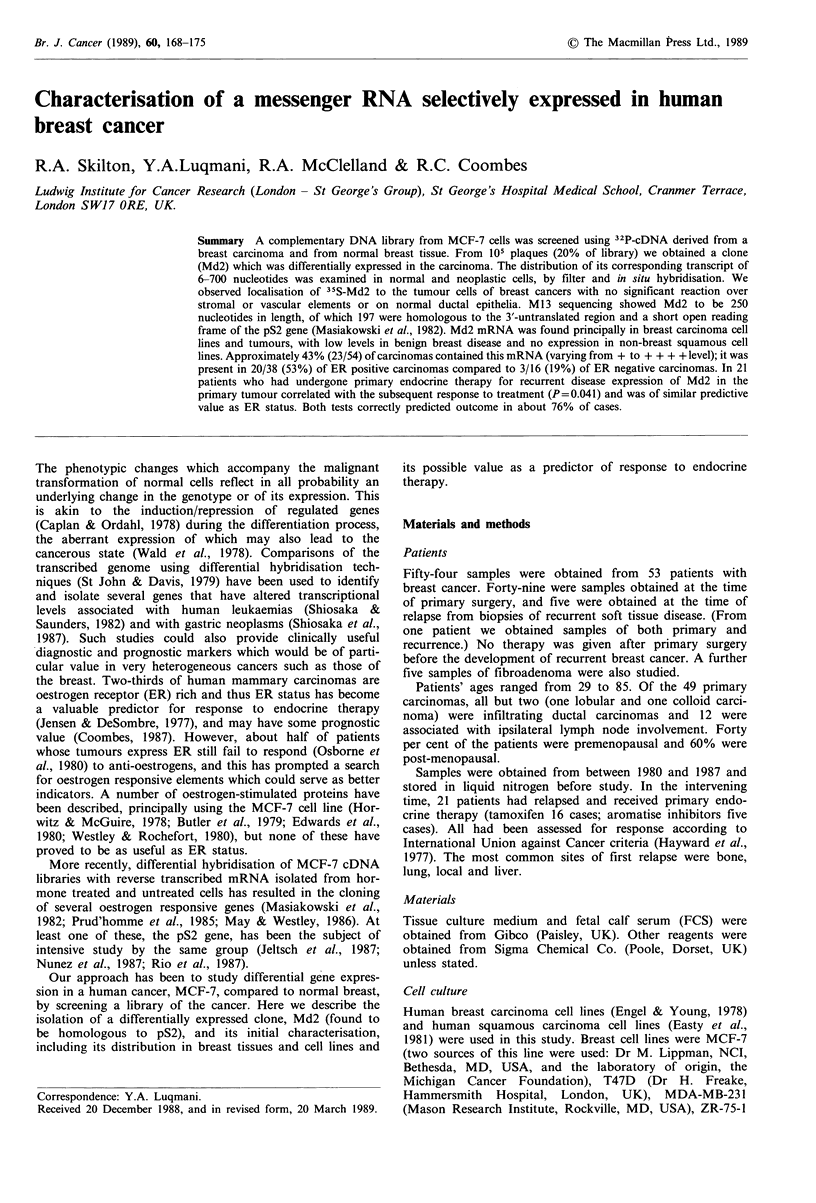

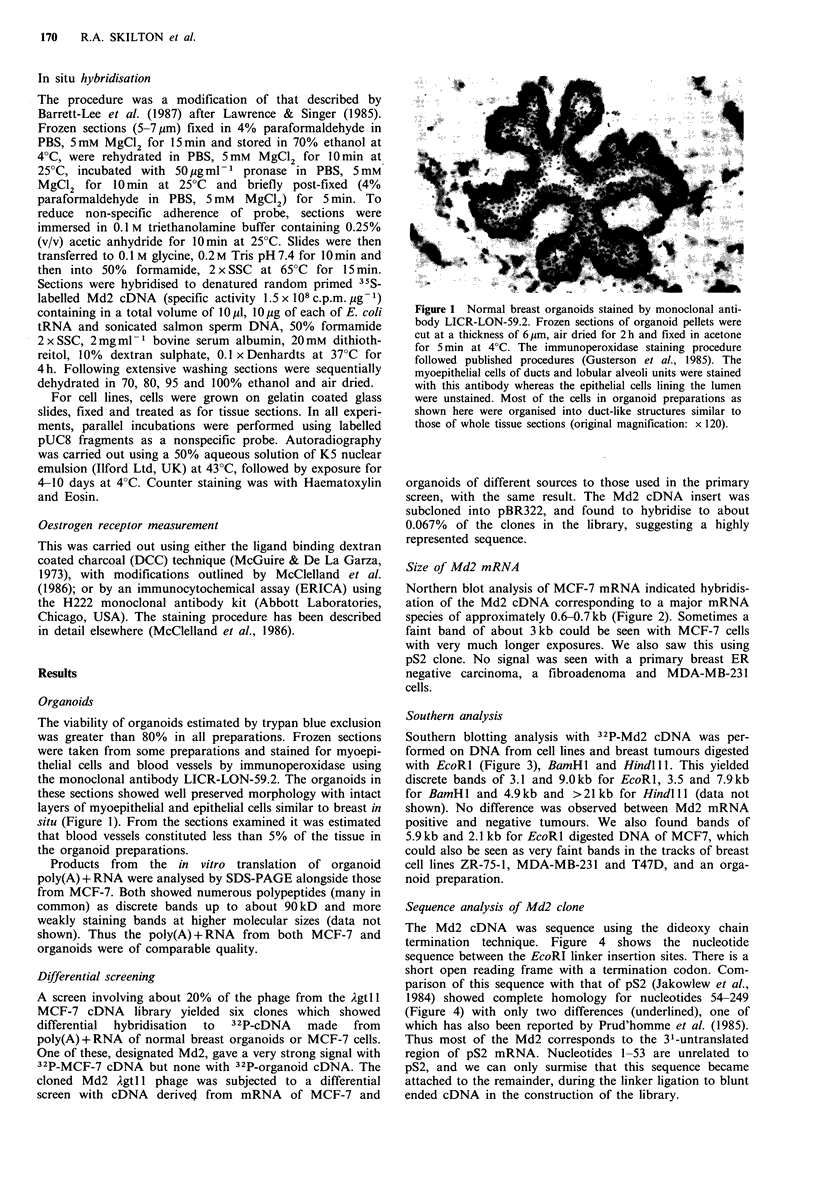
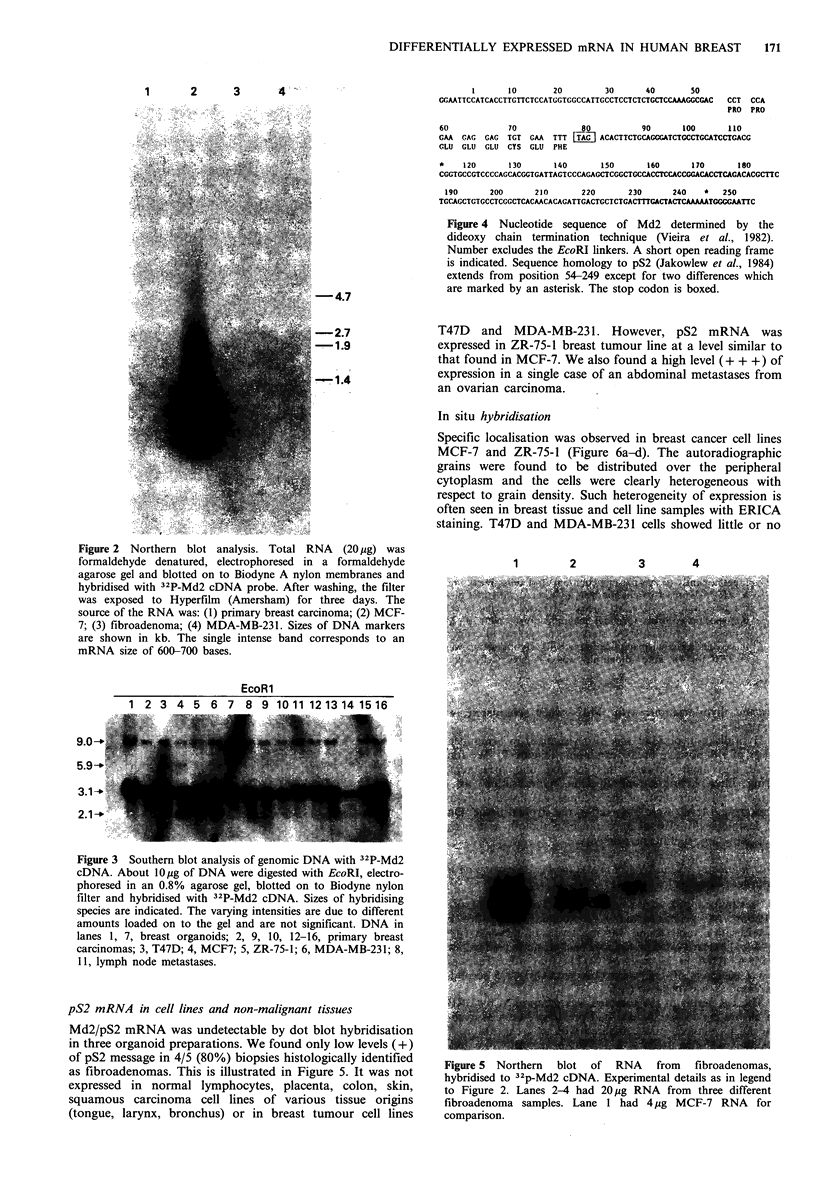
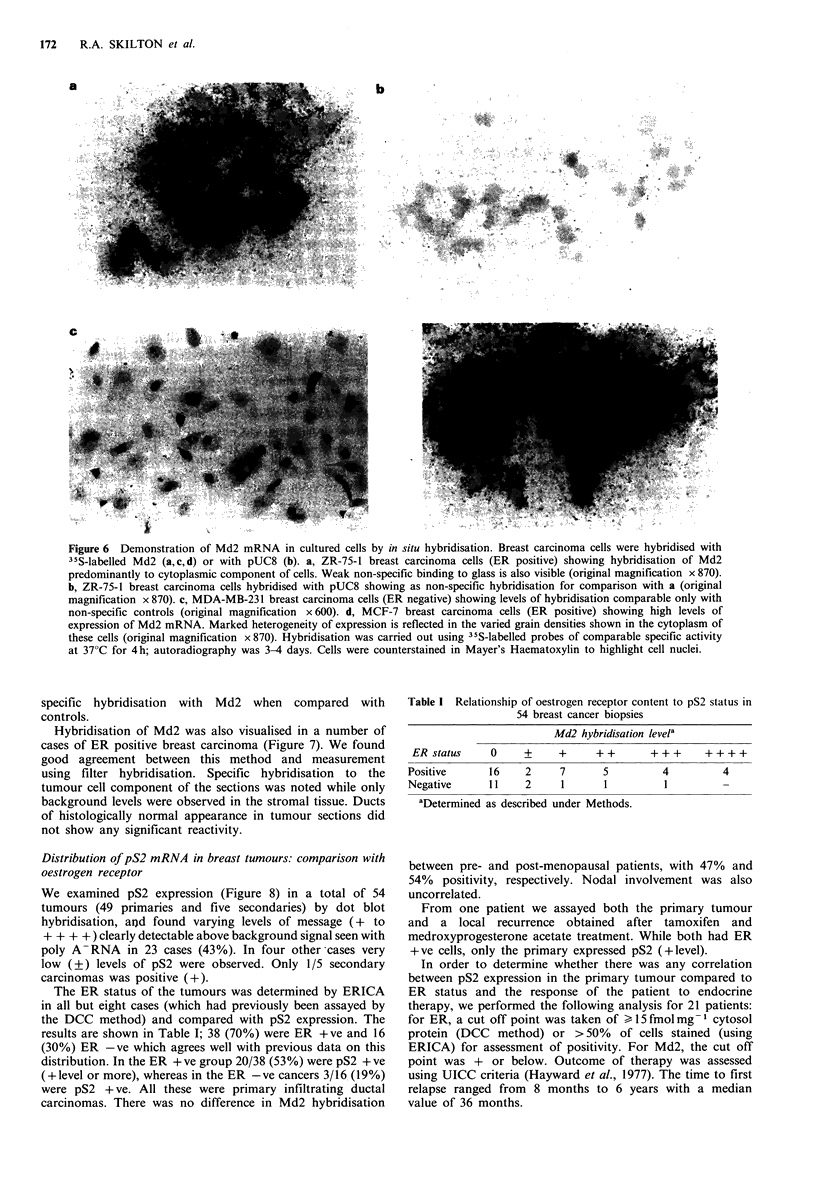
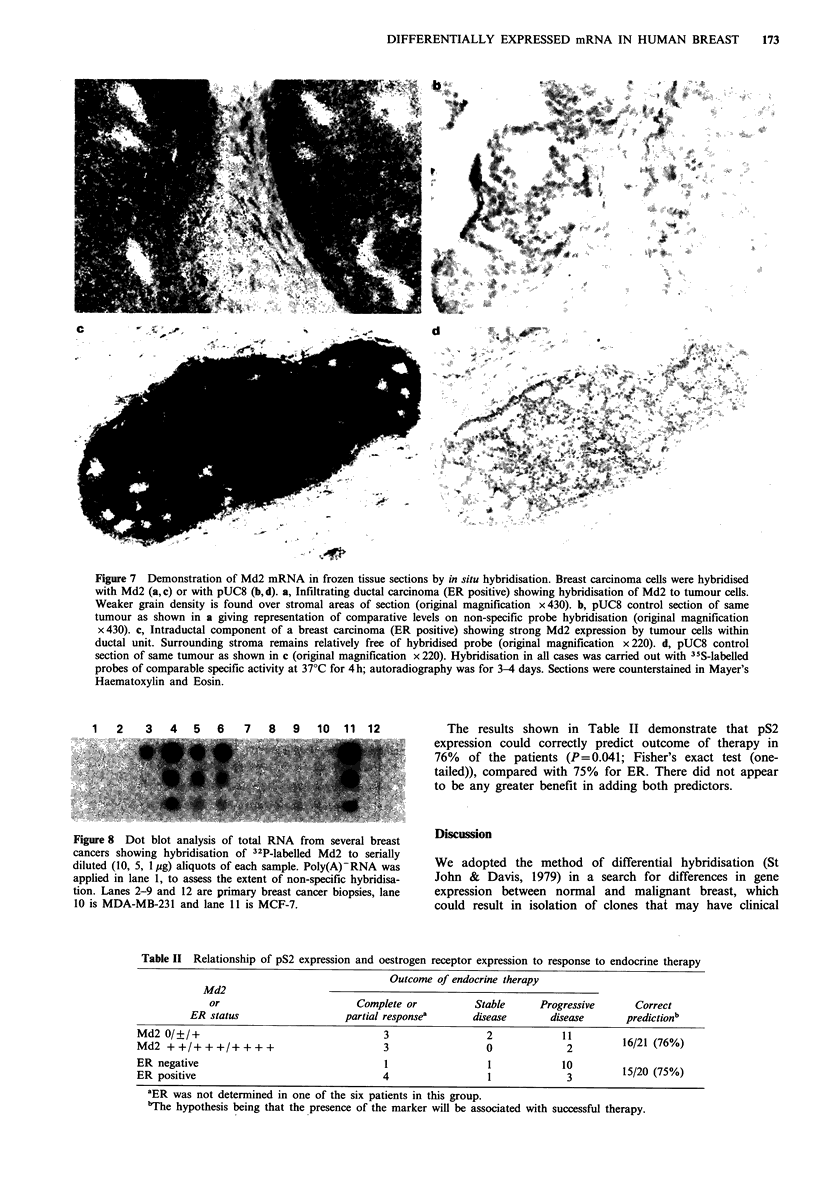
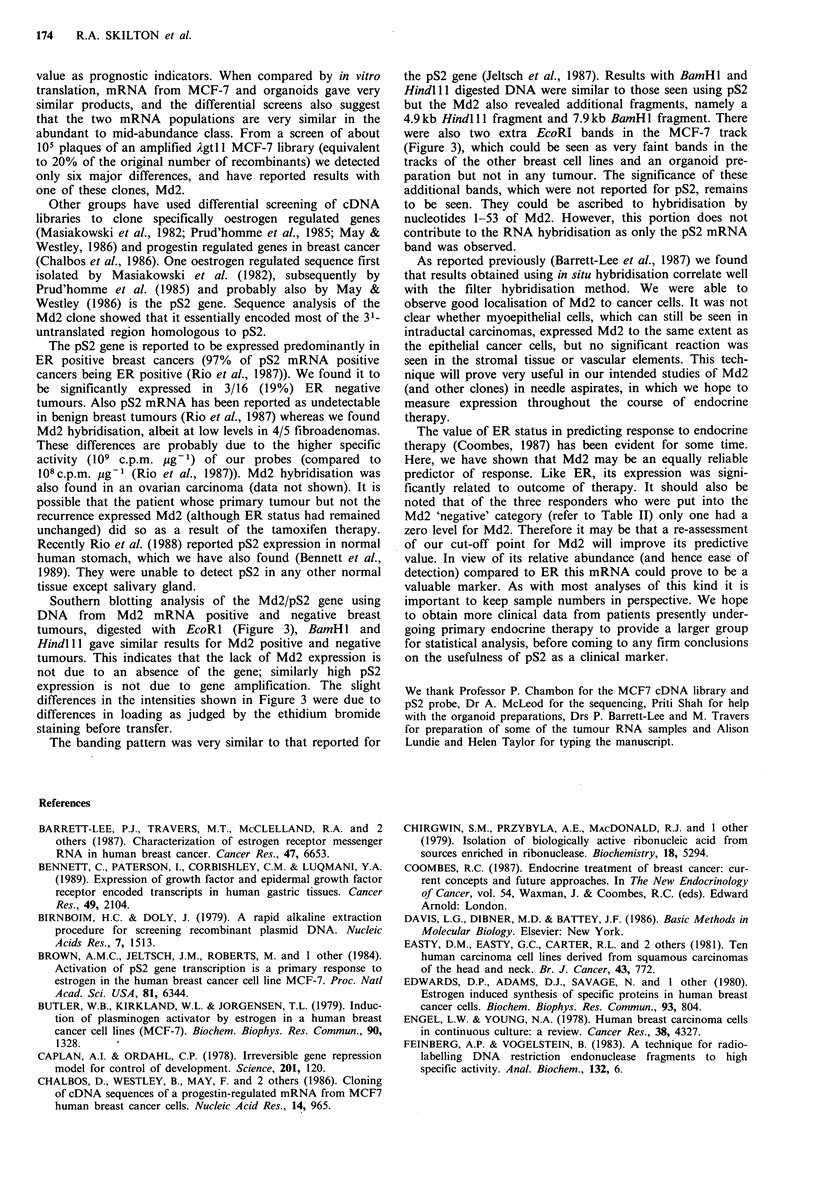
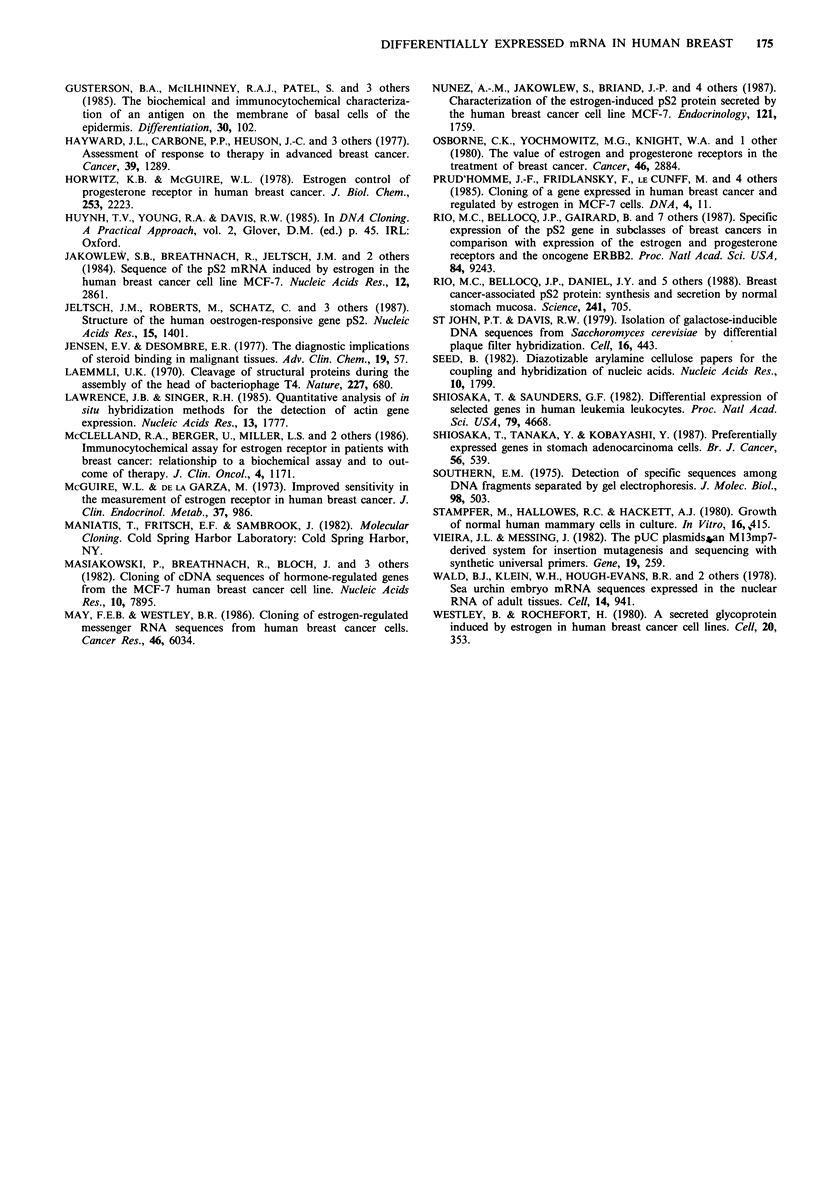
Images in this article
Selected References
These references are in PubMed. This may not be the complete list of references from this article.
- Barrett-Lee P. J., Travers M. T., McClelland R. A., Luqmani Y., Coombes R. C. Characterization of estrogen receptor messenger RNA in human breast cancer. Cancer Res. 1987 Dec 15;47(24 Pt 1):6653–6659. [PubMed] [Google Scholar]
- Bennett C., Paterson I. M., Corbishley C. M., Luqmani Y. A. Expression of growth factor and epidermal growth factor receptor encoded transcripts in human gastric tissues. Cancer Res. 1989 Apr 15;49(8):2104–2111. [PubMed] [Google Scholar]
- Birnboim H. C., Doly J. A rapid alkaline extraction procedure for screening recombinant plasmid DNA. Nucleic Acids Res. 1979 Nov 24;7(6):1513–1523. doi: 10.1093/nar/7.6.1513. [DOI] [PMC free article] [PubMed] [Google Scholar]
- Brown A. M., Jeltsch J. M., Roberts M., Chambon P. Activation of pS2 gene transcription is a primary response to estrogen in the human breast cancer cell line MCF-7. Proc Natl Acad Sci U S A. 1984 Oct;81(20):6344–6348. doi: 10.1073/pnas.81.20.6344. [DOI] [PMC free article] [PubMed] [Google Scholar]
- Butler W. B., Kirkland W. L., Jorgensen T. L. Induction of plasminogen activator by estrogen in a human breast cancer cell line (MCF-7). Biochem Biophys Res Commun. 1979 Oct 29;90(4):1328–1334. doi: 10.1016/0006-291x(79)91181-1. [DOI] [PubMed] [Google Scholar]
- Caplan A. I., Ordahl C. P. Irreversible gene repression model for control of development. Science. 1978 Jul 14;201(4351):120–130. doi: 10.1126/science.351805. [DOI] [PubMed] [Google Scholar]
- Chalbos D., Westley B., May F., Alibert C., Rochefort H. Cloning of cDNA sequences of a progestin-regulated mRNA from MCF7 human breast cancer cells. Nucleic Acids Res. 1986 Jan 24;14(2):965–982. doi: 10.1093/nar/14.2.965. [DOI] [PMC free article] [PubMed] [Google Scholar]
- Chirgwin J. M., Przybyla A. E., MacDonald R. J., Rutter W. J. Isolation of biologically active ribonucleic acid from sources enriched in ribonuclease. Biochemistry. 1979 Nov 27;18(24):5294–5299. doi: 10.1021/bi00591a005. [DOI] [PubMed] [Google Scholar]
- Easty D. M., Easty G. C., Carter R. L., Monaghan P., Butler L. J. Ten human carcinoma cell lines derived from squamous carcinomas of the head and neck. Br J Cancer. 1981 Jun;43(6):772–785. doi: 10.1038/bjc.1981.115. [DOI] [PMC free article] [PubMed] [Google Scholar]
- Edwards D. P., Adams D. J., Savage N., McGuire W. L. Estrogen induced synthesis of specific proteins in human breast cancer cells. Biochem Biophys Res Commun. 1980 Apr 14;93(3):804–812. doi: 10.1016/0006-291x(80)91148-1. [DOI] [PubMed] [Google Scholar]
- Engel L. W., Young N. A. Human breast carcinoma cells in continuous culture: a review. Cancer Res. 1978 Nov;38(11 Pt 2):4327–4339. [PubMed] [Google Scholar]
- Feinberg A. P., Vogelstein B. A technique for radiolabeling DNA restriction endonuclease fragments to high specific activity. Anal Biochem. 1983 Jul 1;132(1):6–13. doi: 10.1016/0003-2697(83)90418-9. [DOI] [PubMed] [Google Scholar]
- Gusterson B. A., McIlhinney R. A., Patel S., Knight J., Monaghan P., Ormerod M. G. The biochemical and immunocytochemical characterisation of an antigen on the membrane of basal cells of the epidermis. Differentiation. 1985;30(2):102–110. doi: 10.1111/j.1432-0436.1985.tb00521.x. [DOI] [PubMed] [Google Scholar]
- Hayward J. L., Carbone P. P., Heuson J. C., Kumaoka S., Segaloff A., Rubens R. D. Assessment of response to therapy in advanced breast cancer: a project of the Programme on Clinical Oncology of the International Union Against Cancer, Geneva, Switzerland. Cancer. 1977 Mar;39(3):1289–1294. doi: 10.1002/1097-0142(197703)39:3<1289::aid-cncr2820390340>3.0.co;2-f. [DOI] [PubMed] [Google Scholar]
- Horwitz K. B., McGuire W. L. Estrogen control of progesterone receptor in human breast cancer. Correlation with nuclear processing of estrogen receptor. J Biol Chem. 1978 Apr 10;253(7):2223–2228. [PubMed] [Google Scholar]
- Jakowlew S. B., Breathnach R., Jeltsch J. M., Masiakowski P., Chambon P. Sequence of the pS2 mRNA induced by estrogen in the human breast cancer cell line MCF-7. Nucleic Acids Res. 1984 Mar 26;12(6):2861–2878. doi: 10.1093/nar/12.6.2861. [DOI] [PMC free article] [PubMed] [Google Scholar]
- Jeltsch J. M., Roberts M., Schatz C., Garnier J. M., Brown A. M., Chambon P. Structure of the human oestrogen-responsive gene pS2. Nucleic Acids Res. 1987 Feb 25;15(4):1401–1414. doi: 10.1093/nar/15.4.1401. [DOI] [PMC free article] [PubMed] [Google Scholar]
- Jensen E. V., Desombre E. R. The diagnostic implications of steroid binding in malignant tissues. Adv Clin Chem. 1977;19:57–89. doi: 10.1016/s0065-2423(08)60170-5. [DOI] [PubMed] [Google Scholar]
- Laemmli U. K. Cleavage of structural proteins during the assembly of the head of bacteriophage T4. Nature. 1970 Aug 15;227(5259):680–685. doi: 10.1038/227680a0. [DOI] [PubMed] [Google Scholar]
- Lawrence J. B., Singer R. H. Quantitative analysis of in situ hybridization methods for the detection of actin gene expression. Nucleic Acids Res. 1985 Mar 11;13(5):1777–1799. doi: 10.1093/nar/13.5.1777. [DOI] [PMC free article] [PubMed] [Google Scholar]
- Masiakowski P., Breathnach R., Bloch J., Gannon F., Krust A., Chambon P. Cloning of cDNA sequences of hormone-regulated genes from the MCF-7 human breast cancer cell line. Nucleic Acids Res. 1982 Dec 20;10(24):7895–7903. doi: 10.1093/nar/10.24.7895. [DOI] [PMC free article] [PubMed] [Google Scholar]
- May F. E., Westley B. R. Cloning of estrogen-regulated messenger RNA sequences from human breast cancer cells. Cancer Res. 1986 Dec;46(12 Pt 1):6034–6040. [PubMed] [Google Scholar]
- McClelland R. A., Berger U., Miller L. S., Powles T. J., Coombes R. C. Immunocytochemical assay for estrogen receptor in patients with breast cancer: relationship to a biochemical assay and to outcome of therapy. J Clin Oncol. 1986 Aug;4(8):1171–1176. doi: 10.1200/JCO.1986.4.8.1171. [DOI] [PubMed] [Google Scholar]
- McGuire W. L., DeLaGarza M. Improved sensitivity in the measurement of estrogen receptor in human breast cancer. J Clin Endocrinol Metab. 1973 Dec;37(6):986–989. doi: 10.1210/jcem-37-6-986. [DOI] [PubMed] [Google Scholar]
- Nunez A. M., Jakowlev S., Briand J. P., Gaire M., Krust A., Rio M. C., Chambon P. Characterization of the estrogen-induced pS2 protein secreted by the human breast cancer cell line MCF-7. Endocrinology. 1987 Nov;121(5):1759–1765. doi: 10.1210/endo-121-5-1759. [DOI] [PubMed] [Google Scholar]
- Osborne C. K., Yochmowitz M. G., Knight W. A., 3rd, McGuire W. L. The value of estrogen and progesterone receptors in the treatment of breast cancer. Cancer. 1980 Dec 15;46(12 Suppl):2884–2888. doi: 10.1002/1097-0142(19801215)46:12+<2884::aid-cncr2820461429>3.0.co;2-u. [DOI] [PubMed] [Google Scholar]
- Rio M. C., Bellocq J. P., Daniel J. Y., Tomasetto C., Lathe R., Chenard M. P., Batzenschlager A., Chambon P. Breast cancer-associated pS2 protein: synthesis and secretion by normal stomach mucosa. Science. 1988 Aug 5;241(4866):705–708. doi: 10.1126/science.3041593. [DOI] [PubMed] [Google Scholar]
- Rio M. C., Bellocq J. P., Gairard B., Rasmussen U. B., Krust A., Koehl C., Calderoli H., Schiff V., Renaud R., Chambon P. Specific expression of the pS2 gene in subclasses of breast cancers in comparison with expression of the estrogen and progesterone receptors and the oncogene ERBB2. Proc Natl Acad Sci U S A. 1987 Dec;84(24):9243–9247. doi: 10.1073/pnas.84.24.9243. [DOI] [PMC free article] [PubMed] [Google Scholar]
- Seed B. Diazotizable arylamine cellulose papers for the coupling and hybridization of nucleic acids. Nucleic Acids Res. 1982 Mar 11;10(5):1799–1810. doi: 10.1093/nar/10.5.1799. [DOI] [PMC free article] [PubMed] [Google Scholar]
- Shiosaka T., Saunders G. F. Differential expression of selected genes in human leukemia leukocytes. Proc Natl Acad Sci U S A. 1982 Aug;79(15):4668–4671. doi: 10.1073/pnas.79.15.4668. [DOI] [PMC free article] [PubMed] [Google Scholar]
- Shiosaka T., Tanaka Y., Kobayashi Y. Preferentially expressed genes in stomach adenocarcinoma cells. Br J Cancer. 1987 Nov;56(5):539–544. doi: 10.1038/bjc.1987.239. [DOI] [PMC free article] [PubMed] [Google Scholar]
- Southern E. M. Detection of specific sequences among DNA fragments separated by gel electrophoresis. J Mol Biol. 1975 Nov 5;98(3):503–517. doi: 10.1016/s0022-2836(75)80083-0. [DOI] [PubMed] [Google Scholar]
- St John T. P., Davis R. W. Isolation of galactose-inducible DNA sequences from Saccharomyces cerevisiae by differential plaque filter hybridization. Cell. 1979 Feb;16(2):443–452. doi: 10.1016/0092-8674(79)90020-5. [DOI] [PubMed] [Google Scholar]
- Stampfer M., Hallowes R. C., Hackett A. J. Growth of normal human mammary cells in culture. In Vitro. 1980 May;16(5):415–425. doi: 10.1007/BF02618365. [DOI] [PubMed] [Google Scholar]
- Vieira J., Messing J. The pUC plasmids, an M13mp7-derived system for insertion mutagenesis and sequencing with synthetic universal primers. Gene. 1982 Oct;19(3):259–268. doi: 10.1016/0378-1119(82)90015-4. [DOI] [PubMed] [Google Scholar]
- Westley B., Rochefort H. A secreted glycoprotein induced by estrogen in human breast cancer cell lines. Cell. 1980 Jun;20(2):353–362. doi: 10.1016/0092-8674(80)90621-2. [DOI] [PubMed] [Google Scholar]
- Wold B. J., Klein W. H., Hough-Evans B. R., Britten R. J., Davidson E. H. Sea urchin embryo mRNA sequences expressed in the nuclear RNA of adult tissues. Cell. 1978 Aug;14(4):941–950. doi: 10.1016/0092-8674(78)90348-3. [DOI] [PubMed] [Google Scholar]




